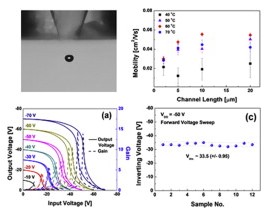Improved performance uniformity of inkjet printed n-channel organic field-effect transistors and complementary inverters
- 저자
- Kang-Jun Baeg, Dongyoon Khim, Ju-Hwan Kim, Minji Kang, In-Kyu You, Dong-Yu Kim and Yong-Young Noh*
- 저널명
- Organic Electronics, 12, 4, 634-640 (2011)
- 년도
- 2011
- Link
- http://dx.doi.org/10.1016/j.orgel.2011.01.016 405회 연결
[Abstract]
In the present study, we demonstrate inkjet-printed n-type organic field-effect transistors (OFETs) and their complementary inverters with high performance uniformity, using soluble N,N′-bis(n-octyl)-(1,7&1,6)-dicyanoperylene-3,4:9,10-bis(dicarboximide) (PDI8-CN2). The device performance and uniformity were improved by ink-jet printing a PDI8-CN2 solution onto a heated substrate (60 °C). The printed features, which were discontinuous crystalline films at RT, were uniform films when the substrate temperature was increased to 60 °C. Optimized n-channel PDI8-CN2 FETs showed a high field-effect mobility of 0.05–0.06 cm2/Vs, a high on/off ratio of ∼106, and a high uniformity that was within 10% with a bottom-gate/bottom-contact device configuration. Inkjet-printed organic complementary inverters were constructed by direct inkjet-printing of n-channel (PDI8-CN2) and p-channel (6,13-bis(triisopropyl-silylethynyl)-pentacene or poly(3-hexylthiophene)) organic semiconductors onto silicon dioxide gate dielectrics. The inkjet-printed organic complementary inverters exhibited a high voltage gain of more than 15 and small standard deviation of inverting voltage and gain of ±0.95 V and ±0.56, respectively, for measuring 12 samples from four difference batches.
